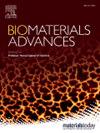A facilely prepared dual-crosslinking adhesive with enhanced adhesive strength for hemostasis and infected wound healing
IF 5.5
2区 医学
Q2 MATERIALS SCIENCE, BIOMATERIALS
Materials Science & Engineering C-Materials for Biological Applications
Pub Date : 2025-05-16
DOI:10.1016/j.bioadv.2025.214349
引用次数: 0
Abstract
Although biological adhesives have shown advantages in replacing traditional wound suturing techniques, there are still limitations in wound closure, hemostasis, and healing, including insufficient tissue adhesion, potential biological toxicity, and complex preparation processes. In this study, a facile route for preparing injectable dual-crosslinking multifunctional hydrogel adhesive (Gel/EN/FBTA) was developed. The Gel/EN/FBTA adhesive is a dynamic cross-linked network composed of tannic acid (TA), 3-formylphenylboronic acid (3-FPBA) and gelatin, which can provide a large number of bonding sites and strengthen the adhesive cohesion through energy dissipation. The amidation reaction inside gelatin can form stable rigid crosslinks and maintain the structure of the adhesive stably. The balance between adhesion and cohesion can be regulated by adjusting the chemical composition and crosslinking density of the dual-crosslinking network. Under this equilibrium condition, the adhesion strength of Gel/EN/FBTA2 hydrogel is 3 times that of commercial fibrin glue, which shows good hemostatic effects in rat liver injury, rat tail injury, and rabbit liver cross incision models. Furthermore, Gel/EN/FBTA2 hydrogel adhesive can effectively treat wound infection, reduce inflammation level, promote re-epithelialization, accelerate collagen deposition, and achieve the healing of infectious full-thickness wounds. This dual-network design paradigm provides a versatile strategy for developing next-generation bioadhesives with tailored mechanical and bioactive properties, demonstrating significant potential for non-compressible hemorrhage and infected wound management.
一种制备简便的双交联胶粘剂,粘合力强,用于止血和感染伤口愈合
尽管生物胶粘剂在替代传统伤口缝合技术方面具有优势,但在伤口闭合、止血和愈合方面仍存在局限性,包括组织粘连不足、潜在的生物毒性、制备工艺复杂等。本研究开发了一种制备注射用双交联多功能水凝胶胶(Gel/EN/FBTA)的简便方法。Gel/EN/FBTA胶粘剂是由单宁酸(TA)、3-甲酰苯基硼酸(3-FPBA)和明胶组成的动态交联网络,可以提供大量的键合位点,并通过能量耗散增强胶粘剂的内聚性。明胶内部的酰胺化反应可以形成稳定的刚性交联,稳定地维持胶粘剂的结构。通过调节双交联网络的化学成分和交联密度,可以调节粘接和内聚的平衡。在此平衡条件下,凝胶/EN/FBTA2水凝胶的粘附强度是市产纤维蛋白胶的3倍,在大鼠肝损伤、大鼠尾损伤和兔肝交叉切口模型中均表现出良好的止血效果。Gel/EN/FBTA2水凝胶粘接剂能有效治疗创面感染,降低炎症水平,促进再上皮化,加速胶原沉积,实现感染性全层创面愈合。这种双网络设计范例为开发具有定制机械和生物活性特性的下一代生物粘合剂提供了多种策略,在不可压缩性出血和感染伤口管理方面显示出巨大的潜力。
本文章由计算机程序翻译,如有差异,请以英文原文为准。
求助全文
约1分钟内获得全文
求助全文
来源期刊
CiteScore
17.80
自引率
0.00%
发文量
501
审稿时长
27 days
期刊介绍:
Biomaterials Advances, previously known as Materials Science and Engineering: C-Materials for Biological Applications (P-ISSN: 0928-4931, E-ISSN: 1873-0191). Includes topics at the interface of the biomedical sciences and materials engineering. These topics include:
• Bioinspired and biomimetic materials for medical applications
• Materials of biological origin for medical applications
• Materials for "active" medical applications
• Self-assembling and self-healing materials for medical applications
• "Smart" (i.e., stimulus-response) materials for medical applications
• Ceramic, metallic, polymeric, and composite materials for medical applications
• Materials for in vivo sensing
• Materials for in vivo imaging
• Materials for delivery of pharmacologic agents and vaccines
• Novel approaches for characterizing and modeling materials for medical applications
Manuscripts on biological topics without a materials science component, or manuscripts on materials science without biological applications, will not be considered for publication in Materials Science and Engineering C. New submissions are first assessed for language, scope and originality (plagiarism check) and can be desk rejected before review if they need English language improvements, are out of scope or present excessive duplication with published sources.
Biomaterials Advances sits within Elsevier''s biomaterials science portfolio alongside Biomaterials, Materials Today Bio and Biomaterials and Biosystems. As part of the broader Materials Today family, Biomaterials Advances offers authors rigorous peer review, rapid decisions, and high visibility. We look forward to receiving your submissions!

 求助内容:
求助内容: 应助结果提醒方式:
应助结果提醒方式:


